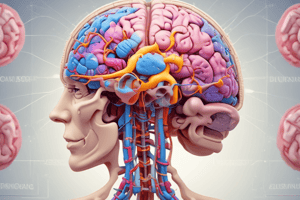Podcast
Questions and Answers
Which cranial nerve is primarily responsible for taste and swallowing?
Which cranial nerve is primarily responsible for taste and swallowing?
- Accessory (XI)
- Glossopharyngeal (IX) (correct)
- Oculomotor (III)
- Facial (VII)
Which part of the brain is associated with processing visual stimuli?
Which part of the brain is associated with processing visual stimuli?
- Primary Somatosensory Cortex
- Somatosensory Association Area
- Primary Visual Cortex (correct)
- Reticular Formation
What is the primary function of the Reticular Activating System (RAS)?
What is the primary function of the Reticular Activating System (RAS)?
- Regulating arousal and attention (correct)
- Emotional regulation
- Processing tactile information
- Coordination of movement
Which cranial nerve is involved in both hearing and balance?
Which cranial nerve is involved in both hearing and balance?
Which brain structure is involved in emotional regulation and memory formation?
Which brain structure is involved in emotional regulation and memory formation?
Which cranial nerve primarily controls eye movement?
Which cranial nerve primarily controls eye movement?
What type of functions does the Trigeminal nerve (V) have?
What type of functions does the Trigeminal nerve (V) have?
Which part of the nervous system does the Vagus nerve (X) primarily influence?
Which part of the nervous system does the Vagus nerve (X) primarily influence?
What is the primary role of the Corpus Callosum?
What is the primary role of the Corpus Callosum?
Which cerebellar peduncle connects the cerebellum to the medulla oblongata?
Which cerebellar peduncle connects the cerebellum to the medulla oblongata?
Which lobe of the brain is primarily responsible for auditory processing and memory?
Which lobe of the brain is primarily responsible for auditory processing and memory?
What function is primarily attributed to the Primary Motor Cortex?
What function is primarily attributed to the Primary Motor Cortex?
Which area of the brain is involved in the planning of movements?
Which area of the brain is involved in the planning of movements?
Which lobe is primarily responsible for processing tactile information?
Which lobe is primarily responsible for processing tactile information?
What is NOT a function of the Limbic System?
What is NOT a function of the Limbic System?
Which structure connects the two hemispheres of the cerebellum?
Which structure connects the two hemispheres of the cerebellum?
Flashcards
Olfactory Nerve (I)
Olfactory Nerve (I)
Sensory nerve responsible for smell.
Optic Nerve (II)
Optic Nerve (II)
Sensory nerve for vision.
Motor Cranial Nerves
Motor Cranial Nerves
Cranial nerves controlling muscle movement.
Mixed Cranial Nerves
Mixed Cranial Nerves
Signup and view all the flashcards
Sensory Cranial Nerves
Sensory Cranial Nerves
Signup and view all the flashcards
Primary Somatosensory Cortex
Primary Somatosensory Cortex
Signup and view all the flashcards
Reticular Formation
Reticular Formation
Signup and view all the flashcards
Cranial Nerve VIII
Cranial Nerve VIII
Signup and view all the flashcards
Cerebellum function
Cerebellum function
Signup and view all the flashcards
Vermis
Vermis
Signup and view all the flashcards
Cerebellar peduncles
Cerebellar peduncles
Signup and view all the flashcards
Corpus Callosum
Corpus Callosum
Signup and view all the flashcards
Frontal Lobe: Function
Frontal Lobe: Function
Signup and view all the flashcards
Parietal Lobe: Function
Parietal Lobe: Function
Signup and view all the flashcards
Limbic System: Function
Limbic System: Function
Signup and view all the flashcards
Reticular Formation: Function
Reticular Formation: Function
Signup and view all the flashcards
Study Notes
Cranial Nerves
- Twelve pairs of cranial nerves
- Sensory functions: Olfactory (I), Optic (II), Vestibulocochlear (VIII)
- Motor functions: Oculomotor (III), Trochlear (IV), Abducens (VI), Accessory (XI), Hypoglossal (XII)
- Mixed functions: Trigeminal (V), Facial (VII), Glossopharyngeal (IX), Vagus (X)
Limbic System
- Involved in emotional regulation, memory formation, and motivation
- Integrates emotional responses with physiological functions
Reticular Formation
- Network of neurons in the brainstem
- Regulates arousal, sleep-wake cycles, and attention
Reticular Activating System (RAS)
- Part of the reticular formation
- Maintains alertness and consciousness; filters sensory information and prioritizes stimuli
Primary Somatosensory Cortex
- Processes tactile information (postcentral gyrus)
Somatosensory Association Area
- Integrates sensory information for perception
Primary Visual Cortex
- Processes visual stimuli
Visual Association Area
- Interprets and integrates visual information
Cranial Nerve Functions & Locations
- Olfactory (I): Smell; located in the olfactory bulb
- Optic (II): Vision; originates in the retina
- Oculomotor (III): Eye movement; arises from the midbrain
- Trochlear (IV): Eye movement; arises from the midbrain
- Trigeminal (V): Facial sensation and mastication; located in the pons
- Abducens (VI): Eye movement; arises from the pons
- Facial (VII): Facial movement and taste; located in the pons
- Vestibulocochlear (VIII): Hearing and balance; located in the pons/medulla
- Glossopharyngeal (IX): Taste and swallowing; arises from the medulla
- Vagus (X): Autonomic functions; arises from the medulla
- Accessory (XI): Neck and shoulder movement; arises from the spinal cord
- Hypoglossal (XII): Tongue movement; arises from the medulla
Studying That Suits You
Use AI to generate personalized quizzes and flashcards to suit your learning preferences.




